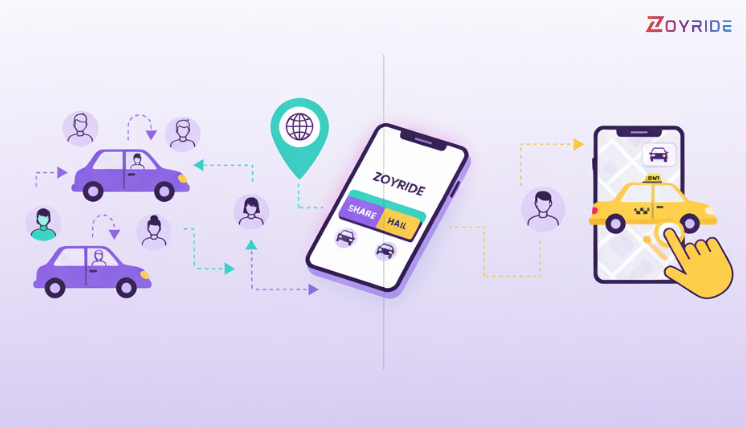
The transportation industry has transformed dramatically in the last decade. Gone are the days when booking a ride meant calling a dispatcher or waving down a taxi on the street. Today, technology has redefined how passengers connect with vehicles, and two models dominate the landscape: ride-sharing and ride-hailing.
While the terms are often used interchangeably, they represent two very different business models. Understanding the difference is key for any operator aiming to grow, adapt, and stay competitive in a fast-changing market.
In this blog, we’ll break down the distinctions, explore the opportunities and challenges of both, and help you decide which model best fits your goals.
What is Ride-Hailing?
Ride-hailing refers to the on-demand transport service where passengers book a private ride through an app, and a driver picks them up and drops them off at their exact destination. Popular examples include Uber, Lyft, Ola, and Grab.
Key features of ride-hailing include:
- One-to-one service: A passenger (or group traveling together) gets the vehicle exclusively.
- On-demand booking: Rides are requested instantly through an app.
- Direct fares: The passenger pays only for their trip, without sharing costs with strangers.
- Dynamic pricing: Fares may change based on demand, distance, or surge rates.
Ride-hailing essentially digitized the traditional taxi model, adding convenience, automation, and transparency.
What is Ride-Sharing?
Ride-sharing, on the other hand, is about sharing a ride with strangers heading in the same direction. The concept is designed to make transportation more cost-effective and eco-friendly by maximizing seat usage.
Key features of ride-sharing include:
- Shared costs: Passengers split the fare, making it cheaper than a private ride.
- Route matching: Algorithms group riders traveling along similar routes.
- Efficiency & sustainability: Fewer cars on the road means reduced traffic and emissions.
- Flexibility: Some models allow recurring rides (e.g., daily office commute shuttles ).
Platforms like BlaBlaCar (long-distance sharing) and UberPOOL (city sharing) are examples of this model.
Ride-Hailing vs Ride-Sharing: The Key Differences
| Factor | Ride-Hailing | Ride-Sharing |
|---|---|---|
| Service Type | Private, direct trips | Shared trips with other passengers |
| Cost | Higher (private ride) | Lower (cost split among riders) |
| Passenger Experience | More comfort, privacy, speed | More affordable, but less privacy |
| Driver Earnings | Higher per trip | Spread across multiple riders |
| Best Use Case | Urgent rides, airport transfers, late-night trips | Daily commutes, cost-saving travel, eco-friendly options |
| Scalability | Easier to scale in urban markets | Works best in high-density areas with similar travel routes |
Which Model Works Better in Different Scenarios?
- Urban Cities with Heavy Demand: Ride-hailing thrives here, where passengers value speed and convenience.
- Corporate & Employee Commutes: Ride-sharing is ideal, offering recurring trips at lower costs.
- Tourism & Airport Transfers: Ride-hailing offers flexibility and privacy that travelers prefer.
- Sustainability-Focused Regions: Governments and eco-conscious customers are pushing for more ride-sharing.
Both models can co-exist in the same market, and many operators now offer a hybrid approach to capture wider demand.
Opportunities for Taxi Operators
-
Increased Reach
Ride-hailing apps allow operators to serve on-demand customers instantly. Ride-sharing expands reach by attracting price-sensitive customers and eco-conscious commuters. -
Maximizing Fleet Utilization
Instead of vehicles sitting idle, both models help keep drivers active—ride-hailing during peak demand, and ride-sharing during regular commutes. -
Better Data Insights
Digital booking platforms provide real-time analytics on customer demand, popular routes, and fare optimization. -
Loyalty & Brand Building
A branded app offering modern features —like live tracking, cashless payments, and shared rides—keeps customers engaged and loyal.
Challenges You Should Be Aware Of
- Pricing Pressure: Ride-sharing fares are low, which can affect margins.
- Driver Onboarding: Operators must train drivers to manage both shared and private rides efficiently.
- Technology Dependence: Success depends on having a robust platform for route-matching, dispatch, and payments.
- Regulatory Hurdles: Some regions have strict rules for shared rides, particularly around safety and licensing.
By addressing these challenges with the right software and processes, operators can run both models profitably.
Market Trends You Should Watch
- Hybrid Models Are Growing – Platforms now allow passengers to choose between private or shared rides in the same app.
- Corporate Mobility Solutions – Ride-sharing is gaining popularity for employee transport, with recurring subscriptions.
- Sustainability Push – Governments are encouraging shared rides to reduce carbon footprints.
- AI and Automation – Smart algorithms are improving driver dispatch, route optimization, and ride-matching .
Conclusion
The debate between ride-hailing and ride-sharing isn’t about choosing one over the other—it’s about knowing when and how to use each. Ride-hailing offers privacy and speed, while ride-sharing provides affordability and sustainability. Together, they shape the future of urban mobility.
With a white-label platform like Zoyride, operators can run both models seamlessly, customizing services for their market while staying competitive with global brands. Going digital ensures you don’t just keep up with customer expectations—you exceed them.
FAQs
Q1. Which is more profitable—ride-hailing or ride-sharing?
It depends on your market. Ride-hailing brings higher fares per trip, while ride-sharing increases trip volume and vehicle utilization.
Q2. Do passengers prefer privacy or lower fares?
Both segments exist. Urban professionals often prefer private rides, while students and daily commuters lean towards shared rides for affordability.
Q3. Can a single platform support both models?
Yes. Many modern taxi software solutions allow you to manage ride-hailing and ride-sharing within one app.
Q4. Is ride-sharing safe for passengers?
Yes, as long as the software includes real-time tracking, verified driver profiles, and rating systems.
Q5. Should local taxi operators adopt these models?
Adopting one or both models is key to staying competitive against global players. The right choice depends on your target market and resources.